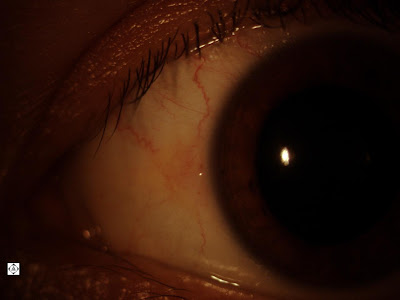

The top photo shows part of a Weiss' Ring that occurs from a posterior vitreous detachment (PVD). The vitreous is like a bag of gel that fills up the eyeball. At some point in most people's lives the bag pulls off the back of the eye, much like wallpaper falling off a wall. The patient can have symptoms of flashes of light and/or floaters. Sometimes it can pull on the retina, causing a tear, which could lead to a retina detachment and subsequent loss of vision. A PVD in and of itself is not dangerous, but the floater could bother a person enough that a retina specialist would have to do surgery to remove it.
The bottom photo is just of a very small amount of clouding of the lens of the eye. When it gets to a point that the patient loses vision, then it is considered a cataract. Of course those are easily fixed with surgery.

 This is the photograph of the peripheral retina of a patient with about 10 diopters of near sightedness. The orange area is normal retina. The white area is the "stretched" area that often happens in very near sighted individuals. It is a risk factor for future retinal tears or holes that can lead to retina detachment which can potentially cause total blindness. Patients with a lot of near-sightedness should be dilated on a yearly basis.
This is the photograph of the peripheral retina of a patient with about 10 diopters of near sightedness. The orange area is normal retina. The white area is the "stretched" area that often happens in very near sighted individuals. It is a risk factor for future retinal tears or holes that can lead to retina detachment which can potentially cause total blindness. Patients with a lot of near-sightedness should be dilated on a yearly basis.




